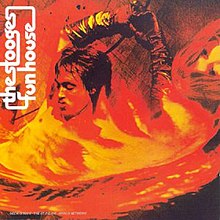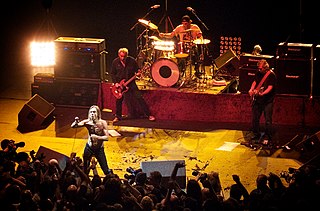
The Stooges, originally billed as the Psychedelic Stooges, and also known as Iggy and the Stooges, were an American rock band formed in Ann Arbor, Michigan, in 1967 by singer Iggy Pop, guitarist Ron Asheton, drummer Scott Asheton, and bassist Dave Alexander. Initially playing a raw, primitive style of rock and roll, the band sold few records in their original incarnation and gained a reputation for their confrontational performances, which often involved acts of self-mutilation by Iggy Pop.
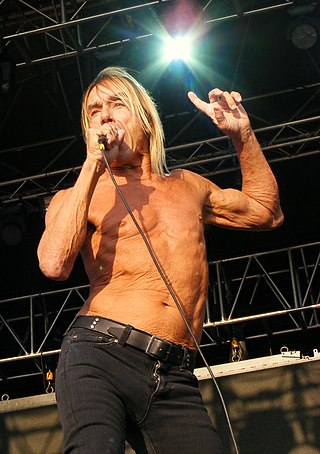
James Newell Osterberg Jr., known professionally as Iggy Pop, is an American singer, musician, songwriter, actor, and radio broadcaster. He was the vocalist and lyricist of proto-punk band The Stooges, who were formed in 1967 and have disbanded and reunited many times since. Often called the "Godfather of Punk", he was named one of the 50 Great Voices by NPR. In 2010, he was inducted into the Rock and Roll Hall of Fame, as a member of the Stooges. Pop also received a Grammy Lifetime Achievement Award in 2020, for his solo work.

Raw Power is the third studio album by American rock band the Stooges, released on February 7, 1973 by Columbia Records. The album departed from the "groove-ridden, feel-based songs" of the band's first two records in favor of a more anthemic hard rock approach inspired by new guitarist James Williamson, who co-wrote the album's eight songs with singer Iggy Pop. Pop produced the recording sessions himself and David Bowie assisted with post-production work, though the team were allotted only one day to mix the album and the resulting fidelity was poor. Later reissues have attempted to either correct or enhance the original mix, most notably Pop's 1997 remix which became notorious for its extreme volume and compression.

L.A. Woman is the sixth studio album by the American rock band the Doors, released on April 19, 1971 by Elektra Records. It is the last to feature lead singer Jim Morrison during his lifetime, due to his death exactly two months and two weeks following the album's release, though he would posthumously appear on the 1978 album An American Prayer. Even more so than its predecessors, the album is heavily influenced by blues. It was recorded without producer Paul A. Rothchild after he quit the band over the perceived lack of quality in their studio performances. Subsequently, the band co-produced the album with longtime sound engineer Bruce Botnick.

Ronald Franklin Asheton was an American musician, who was best known as the guitarist, bassist, and co-songwriter for the rock band the Stooges. He formed the Stooges along with Iggy Pop and his brother, drummer Scott Asheton, and bassist Dave Alexander. Asheton, once ranked as number 29 on Rolling Stone's list of 100 Greatest Guitarists of All Time, is currently ranked at number 60.
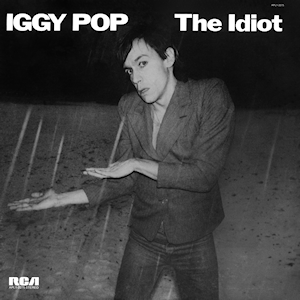
The Idiot is the debut studio album by the American musician Iggy Pop, released on March 18, 1977, through RCA Records. It was produced by David Bowie and primarily recorded at the Château d'Hérouville in Hérouville, France. The album followed the break-up of Pop's band the Stooges in 1974 and a period of drug addiction for both Pop and Bowie, after which the two moved to Europe in an effort to kick their addictions.

The Stooges is the debut studio album by American rock band the Stooges, released on August 5, 1969 by Elektra Records. Considered a landmark proto-punk release, the album peaked at number 106 on the US Billboard Top 200 Albums chart. The tracks "I Wanna Be Your Dog" and "1969" were released as singles; "1969" was featured on Rolling Stone's list of the "100 Greatest Guitar Songs" at number 35. In 2020, it was ranked number 488 on Rolling Stone's 500 Greatest Albums of All Time.

1970: The Complete Fun House Sessions is a seven-CD limited edition boxed set that commemorates and chronicles the entire session for Fun House, the second studio album by American proto-punk band The Stooges.
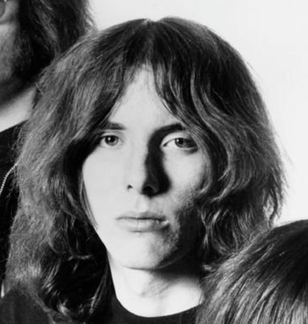
David Michael Alexander was an American musician, best known as the original bassist for influential protopunk band The Stooges. He was inducted into the Rock and Roll Hall of Fame in 2010 as a member of The Stooges.

Scott Randolph Asheton was an American musician, best known as the drummer for the rock band the Stooges.
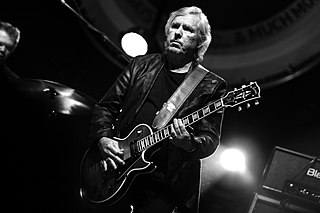
James Robert Williamson is an American guitarist, songwriter, record producer and electronics engineer. He was a member of the iconic proto-punk rock band The Stooges, notably on the influential album Raw Power and in the reformed Stooges from 2009 to 2016. Between his stints in music, Williamson worked in Silicon Valley developing computer chips. Most recently he has continued as a solo artist.

Telluric Chaos is a live album by the reunited Iggy Pop & The Stooges. It chronicles the closing date of the band's first ever Japanese tour, which took place on March 22, 2004, at the Shibuya AX in Tokyo. The album documents a typical reunited Stooges set, primarily drawn from the band's first two albums with no material from the James Williamson era. This live set also includes some of the first live performances of three of the four Stooges reunion tracks from Iggy Pop's 2003 solo album Skull Ring plus one brand new song, "My Idea of Fun".

"Search and Destroy" is a song by American rock band the Stooges, recorded for the group's third album Raw Power (1973). Lead singer Iggy Pop said that the title was derived from a column heading in a Time article about the Vietnam War.
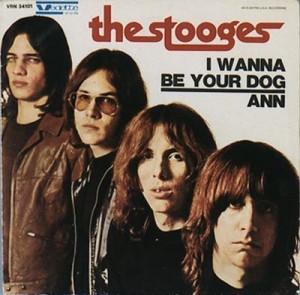
"I Wanna Be Your Dog" is a song by American rock band the Stooges, released as the group's debut single from the band's 1969 self-titled debut album. The riff is composed of only three chords, is played continuously throughout the song. The 3-minute-and-9-second-long song, with its distortion-heavy guitar intro, single-note piano riff played by producer John Cale of the Velvet Underground, and steady, driving beat, gave the cutting edge of the early heavy metal and punk sound.
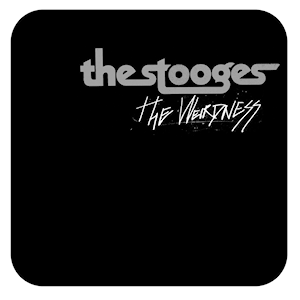
The Weirdness is the fourth studio album by American proto-punk band The Stooges. Released on 5 March 2007, it was the first Stooges album of new material since Raw Power in 1973, and is also the final album to feature guitarist Ron Asheton, who died in early 2009. Founding members Iggy Pop (vocals), Ron Asheton (guitar), and Scott Asheton (drums) are featured, along with new band member Mike Watt, formerly of Minutemen, and returning guest musician Steve Mackay (saxophone), who appeared on The Stooges' 1970 album, Fun House.

Live in Detroit a 2004 DVD release of a live performance by the band The Stooges. The surviving original members of the Stooges reunited in 2003—nearly thirty years after they had disbanded—and scheduled a handful of live shows, including an August 14 concert in their hometown of Detroit. The gig was postponed due to a widespread North America blackout, but the band played at the DTE Energy Music Theatre eleven days later. The performance was released on DVD in March 2004.

The discography of The Stooges—a Detroit, Michigan based rock band founded by "The Godfather of Punk Music" Iggy Pop as singer, Ron Asheton as guitarist, Dave Alexander as bass-guitarist and Scott Asheton as drummer—currently consists of five studio albums, twenty-four singles, four live albums, and three box sets.

Have Some Fun: Live at Ungano's is a live album by the rock band The Stooges. It was originally recorded on August 17, 1970 as an audience recording by Danny Fields, who had signed the band in 1968.
"Been Down So Long" is a song by the American rock band the Doors. It appears as the third track on L.A. Woman, the last studio album that lead singer Jim Morrison recorded with the group. It has been called, notably by critic Robert Christgau, as a "take-off" on the album.
Elektra Sound Recorders was Elektra Records's recording studio in Los Angeles, California, United States located at 962 La Cienega Boulevard. Electric Entertainment currently provides video production services at this location.
